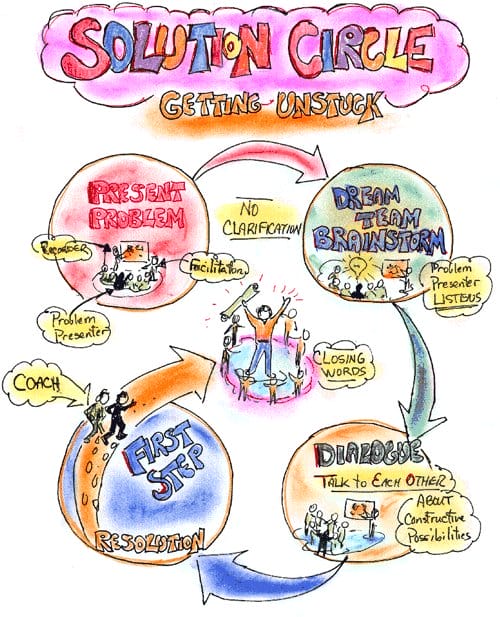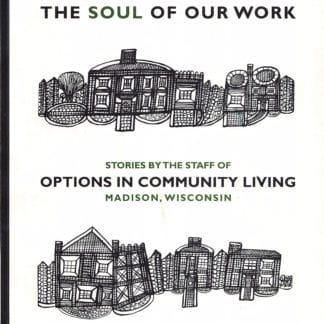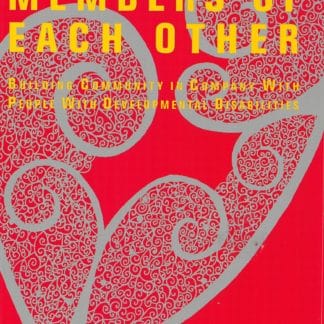
Getting Unstuck A Creative Problem Solving Tool
This is a short and powerful conversational approach that takes no more than a half hour. It is effective in getting “unstuck” from a problem in life or work. Solution Circles build on “community capacity”. It assumes and demonstrates that nearby people – in any community or work place have the capacity to help – if asked. It requires a person to ASK – not an easy thing in our culture of privacy and “do it alone”. This approach puts all the values we espouse into practice and demonstrates that TOGETHER WE’RE BETTER.
Time required: No more than thirty minutes. People per Solution Circle: Best with 5-9.
- Roles to be played:
- Problem Presenter (focus person)
- Process Facilitator (team manager, time keeper)
- Note Taker or Graphic Recorder
- amazingly creative Brainstorm Team
For large groups, the group facilitator (i.e. you) asks the group for volunteer problem presenters. (The number required is the total group divided by 9 approximately). Then ask for a process facilitator and a graphic recorder to attach themselves to each problem presenters so each core team is now a group of 3. The balance of the large group ( i.e. the world’s most creative community members) now join the various problem solving teams so each team totals approximately 8-9 problem solvers. Diversity in teams is best: spread the age range; have male/female diversity; the greater the diversity per team the better.
Explain the steps to the teams in detail:
Step One:
(6 minutes) The problem presenter will have 6 uninterrupted minutes to outline the problem. The job of the process facilitator is to keep time and make sure no one interrupts. The recorder takes notes. Everyone else (the brainstormers) listens. If the problem presenter stops talking before the six minutes elapse, everyone else stays silent until the 6 minutes pass. This is key! The problem presenter gets 6 uninterrupted minutes.
Step two:
(6 minutes) This is a brainstorm. Everyone chimes in with ideas about creative solutions to what they just heard. It is not a time to clarify the problem or to ask questions. It is not a time to give speeches, lectures or advice. The process facilitator must make sure this is a brainstorm. Everyone gets a chance to give their brilliant ideas. No one must be allowed to dominate. The problem presenter listens – without interrupting. He/she must not talk or respond. We often give the person masking tape to facilitate their listening. It’s hard to just listen!
Step 3 :
(6 minutes) Now the group can have a dialogue led by the problem presenter. This is time to explore and clarify the problem. Focus on the positive points only and not what can’t be done.
Step 4:
(6 minutes) The First Step. The focus person and the group decide on first steps that are doable within the next 3 days. At least ONE step should be initiated within 24 hours. This is critical. Research shows that unless a first step is taken almost immediately, people do not get out of their ruts. A coach from the group volunteers to phone or see the person within 3 days and check if they took their first step.
Finally the group just does a round of words to describe the experience and the recorder gives the record to the focus person. If in a large group, the teams returns to the main group, debrief and continue.
In our experiences people love this exercise and find that it generates action. It does not guarantee a solution, but it usually gets people “unstuck” and at least points to the next logical step. Try it out and let us know how it works for you.
This material may be duplicated however not for any profit-driven enterprise.
If copied please notify us on your intentions
Designed by Marsha Forest & Jack Pearpoint
Copyright 1996 Inclusion Press



